
As with other industries, subsea technologies and industrial assets are undergoing a digital transformation. One of the main enablers of this transformation is Cyber-Physical Systems (CPS), which has led to the emergence of a new CPS research programme within the National Subsea Centre (NSC), devoted, amongst other aims, to accelerating digitally enabled transformation in the subsea and maritime environment.
A cyber-physical system is an intelligent system that integrates computing facilities with physical hardware components, creating thereby a highly integrated and interacting networked environment. The purpose of CPS is to support timely interaction and effective communication/collaboration between human, machine, environment, information and other elements of both physical and virtual space.
An everyday example of a cyber-physical system is a smartphone – it integrates a few hardware sensors (e.g., accelerometer, gyroscope) with various software applications utilising the data acquired with the physical sensors, and is then processed, analysed and stored by the applications running in the “cyber” space. Modern industrial CPS add a certain level of intelligence (data analytics, logic and stored knowledge) and networking facilities to follow a recent trend in information science underpinning digital transformation and Industry 4.0.
Two types of data analytics are usually deployed in industrial CPS: historical and real-time. Historical data from multiple sensors collected and stored over a long period of time results in forming so-called Big Data. Industrial cyber-physical systems performing Big Data analytics try to uncover insights from historical data patterns not visible from real-time data, for example, long-term correlations between industrial process variables. Real-time analytics evaluates current data with the purpose of identifying unusual/interesting instances (e.g., operational faults, energy overconsumption etc).
Data analytics can be deployed locally (edge processing and fog computing), or on a virtual machine in the cloud. In the former case, a data historian will play an ever-increasing role in the operations and maintenance of industrial facilities because many applications will have historical data in one form or another (e.g., digital model, shadow or twin). A digital shadow (DS), for instance, has one core function – namely, supplying a sufficient amount of timely process information. Thus, the DS itself is a kind of soft sensor that supplies the right information at the right time and in the right quality.
One example of a cyber-physical system utilising the concept of a digital shadow in a subsea environment, developed in the past by the researchers working within the CPS theme, was an intelligent software solution (V-Sentinel™) that can provide autonomous condition monitoring of subsea control systems. It is a result of a collaboration between Robert Gordon University, NSC and Viper Innovations Ltd., an organisation specialising in asset integrity management and engineering consultancy services related to subsea control.
Traditional subsea production systems are particularly vulnerable to single point failures that affect output from several wells. Inaccessibility of the hardware makes fault diagnosis and localisation a difficult challenge due to inability to see the fault, remoteness of faulty equipment, and the complications of interfering with complex control systems.
For a long period of time, it was common practice to perform the fault diagnosis of subsea control systems retrospectively, in response to a process alarm, by manual data collection and its subsequent analysis. Improving the timelines and efficiency of logged data analysis through soft sensing, using a digital shadow can yield substantial cost savings for the operator by enabling a subsea intervention in controlled circumstances. This is achieved by an effective usage of artificial intelligence and machine learning that reinforce data analytics capabilities of digital shadows used as soft measuring platforms for subsea asset integrity monitoring.
KeyFacts Energy Industry Directory: National Subsea Centre
 KEYFACT Energy
KEYFACT Energy